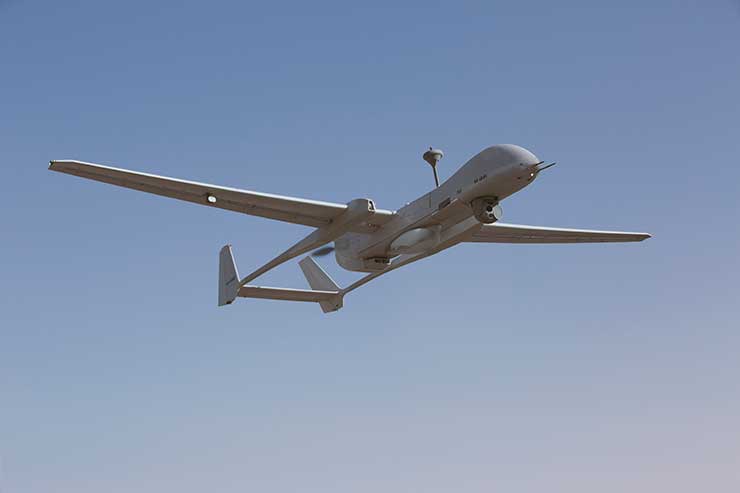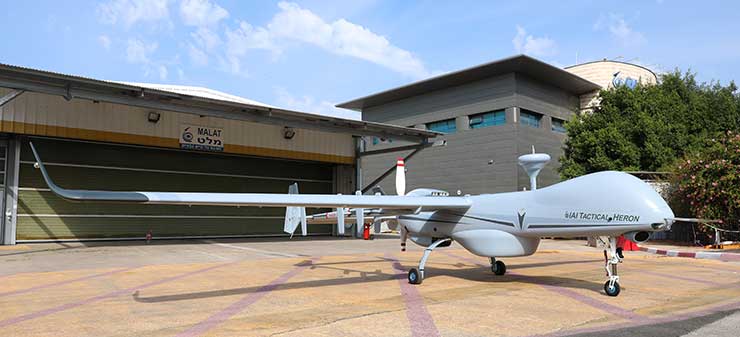
Tel Aviv: Israel Aerospace Industries and Indian company HAL have signed a joint venture agreement to offer Israeli made UAV’s to the Indian armed forces. According to the agreement, a major part of the Israeli developed UAV’s will be manufactured by HAL to fulfil the “Make in India” policy.
According to Avi Bleser, IAI director of marketing India, the joint venture is aimed at offering the Indian armed forces with advanced UAV .” The joint venture will offer two options – purchase or lease and will also be involved in adapting the UAV’s to the Indian regulations.”
Bleser revealed that the first two types offered to the Indian armed forces are the Heron Mk II and Tactical Heron (T-Heron). He said that the Heron Mk II can reach a ceiling of 35,000 feet and a max speed of 140 knots. The Mk II has a wider and longer fuselage than the Heron-1, to allow the installation of additional payloads. MTOW is 1350 Kgs. Max payload weight is 470 kg.
“The new design , and especially the new improved engine gives the Mk II a climb rate that is 50 % greater than the Heron- 1 is capable of.” Bleser said. The Mk II has an endurance of 45 hours. Bleser pointed out the capability of the Heron Mk II to “fly the mission” meaning that the platform fits itself to the mission profile. “To achieve that we installed a flight control computer and a separate dedicated mission computer”.
The new version is equipped with a line of sight communications system and with a satellite communication system. “The improved communications links enable the Mk II to use a large number of payloads in parallel and transmit the data to the different customers” Bleser added.
The Mk II is offered with a variety of dedicated payloads – for ground, air and maritime missions including anti-submarine.
According to IAI, the Heron Mk II is capable of landing and taking off in remote areas using the built in an advanced satellite communications system. This capability is essential when the UAV needs to be operated continuously without going back to its home base. The Heron- Mk II can automatically land in remote runways located thousands of kilometres away, where it is serviced by a small team and basic fuelling infrastructure, before it takes off for an additional mission. This capability is based on the advanced satellite communications systems, combined with precise automated take-off and landing.

The company says that the new capability also leads to substantial saving in command stations and flying staff resources since it eliminates the need to return to the original take-off point for fuelling, thus saving on flight time and fuel. This IAI says, increases the operational availability in the mission area and provides several options for routine and emergency landing.
“With the new capability, Heron Mk II is used in even more complicated and challenging missions,” Bleser said. The new capability was developed based on operational demands that are the result of a long series of tests performed by the flight test squadron of the Israeli air force (IAF).
The second type offered by the new joint venture is the Tactical Heron (T-Heron). According to Avi Bleser, the T-Heron is designed for use by ground troops and coastal guards, as well as by other protection forces.
“With a versatile design and suitable for a variety of payloads, it features the most advanced IAI technologies,” he added.
The T- Heron has a MTOW of 600 kgs including a180 kgs payload. Its endurance is 24 hours. This UAV can fly at a max altitude of 24,000 feet, speed of 120 knots and supports 4 useful payloads concurrently with a total weight of up to 400 pound. The T-Heron complies with global standards, including STANAG 4671 requirements. The T-Heron UAV has a retractable nose landing gear, to allow a radar payload an unobstructed field of view and it has a full automatic take-off and landing (ATOL) capability.















